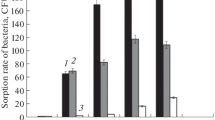Summary
Roots of pea seedlings without lateral roots, inoculated with Rhizobium leguminosarum, were unable to support growth of the bacteria on the root surface. After the formation of lateral roots a strong increase of bacterial numbers on the root surface was observed. This increase was restricted to that part of the main root where lateral roots were present.
When pea seedlings were grown in Petri dishes with their roots on agar (carbon source present), mixed with a suspension of Rhizobium leguminosarum, no zone of stimulated bacterial growth was observed in the vicinity of the root. This was in contrast with seedlings of a number of other legumes which under the same experimental conditions gave a distinct zone of bacterial growth near the roots. Only where lateral roots emerged from the main pea root, a rather weak stimulation of the rhizobia was observed after some time.
Lateral roots of pea seedlings growing in sterile agar along the bottom of the Petri dish upon inoculation with Rhizobium leguminosarum gave a zone of bacterial growth. This zone started at some distance from the root, apparently owing to the presence of a zone of growth inhibition surrounding the roots more closely.
When seedlings of various leguminous plants were grown in tubes with their roots in agar, rhizobial growth occurred along the entire root system down to the bottom of the tube. Growth in the deeper parts of the agar was due to the release of oxygen by the roots. No promotion of growth was found near the roots of pea seedlings. in case the agar was supplemented with yeast extract or glutamic acid, pea plants also promoted the growth of Rhizobium in the vicinity of their roots but in contrast with other plant species used, the zone of promoted growth was not in direct contact with the root surface. re]19740124
Similar content being viewed by others
References
Apel, P. und Weichsel, G., Untersuchungen über die Wechselbeziehungen zwischen höheren Pflanzen und Bakterien in der synthetischen Rhizosphäre III. Die Entwicklung von Rhizobien in N-freien Nährmedien in Mischkultur mit nicht-spezifischen Wirtspflanzen. Zentralbl. f. Bakteriologie, Parasitenkunde, Infektionskrankheiten u Hygiene. II. Abt. 122, 580–596 (1968).
Bird, A. F., The attractiveness of roots to the plant parasitic nematodes Meliodogyne javanica and M. hapla. Nematologica 4, 322–335 (1959).
Bowen, G. D., Chloride efflux along Pinus radiata roots. Nature 218, 686–687 (1968).
Cannon, W. A., Absorption of oxygen by roots when the shoot is in darkness or in light. Plant Physiol. 7, 673–684 (1932).
Egeraat, A. W. S. M. van, Pea-root exudates and their effect upon root-nodule bacteria. Comm. Agr. Univ. Wageningen 72–27 (1972).
Egeraat, A. W. S. M.van, Exudation of ninhydrin-positive compounds by pea-seedling roots: a study of the sites of exudation and of the composition of the exudate. Plant and Soil 42, 37–47 (1975).
Frenzel, B., Zur Ätiologie der Anreicherung von Aminosäuren und Amiden im Wurzelraum von Helianthus annuus L.; Ein Beitrag zur Klärung der Probleme der Rhizosphäre. Planta 55, 169–207 (1960).
Hiltner, L., Über neuere Erfahrungen und Probleme auf dem Gebiet der Bodenbakteriologie und unter besondere Berücksichtigung der Gründüngung und Bracke. Arb. Deut. Landwirtsch. Ges. 98, 59–78 (1904).
Knudson, L., The secretion of invertase by plant roots. Am. J. Botany 7, 371–379 (1920).
Lyon, T. L. and Wilson, J. K., Liberation of organix matter by roots of growing plants. New York Agr. Expt. Sta. (Geneva, N.Y.) Nem. 40, 1–44 (1921).
McDougall, Barbara M., The exudation of C14-labelled substances from roots of wheat seedlings. Trans. 9th Congr. Intern. Soil Sci. Adelaide 3, 647–655 (1968).
Pearson, R. and Parkinson, D., The sites of excretion of ninhydrin-positive substances by broad bean seedlings. Plant and Soil 13, 391–396 (1961).
Raalte, M. H. van, On the oxidation of the environment by the roots of rice (Oryza sative L.). Ann. Bot. Gardens Buitenzorg, Hors Serie 15–34 (1944).
Rovira, A. D., Diffusion of carbon compounds away from wheat roots. Australian J. Biol. Sci. 22, 1287–1290 (1969).
Schroth, M. N. and Snyder, W. C., Exudation patterns from bean seeds and hypocotyls and their effects on Fusarium solani f. phaseoli. (Abstr.) Phytopathology 52, 751 (1962).
Yin, W. Y., Cui, Y. Y. and Lou, C. H., Relationship between downward oxygen transport and intercellular spaces in root cortex of water cultured and moist cultured seedlings. Acta Botan. Sinica 14, 33 (1966).
Zentmyer, G. A., Chemotaxis of zoospores for root exudates. Science 133, 1595–1596 (1961).
Author information
Authors and Affiliations
Rights and permissions
About this article
Cite this article
van Egeraat, A.W.S.M. The growth of Rhizobium leguminosarum on the root surface and in the rhizosphere of pea seedlings in relation to root exudates. Plant Soil 42, 367–379 (1975). https://doi.org/10.1007/BF00010012
Received:
Issue Date:
DOI: https://doi.org/10.1007/BF00010012




